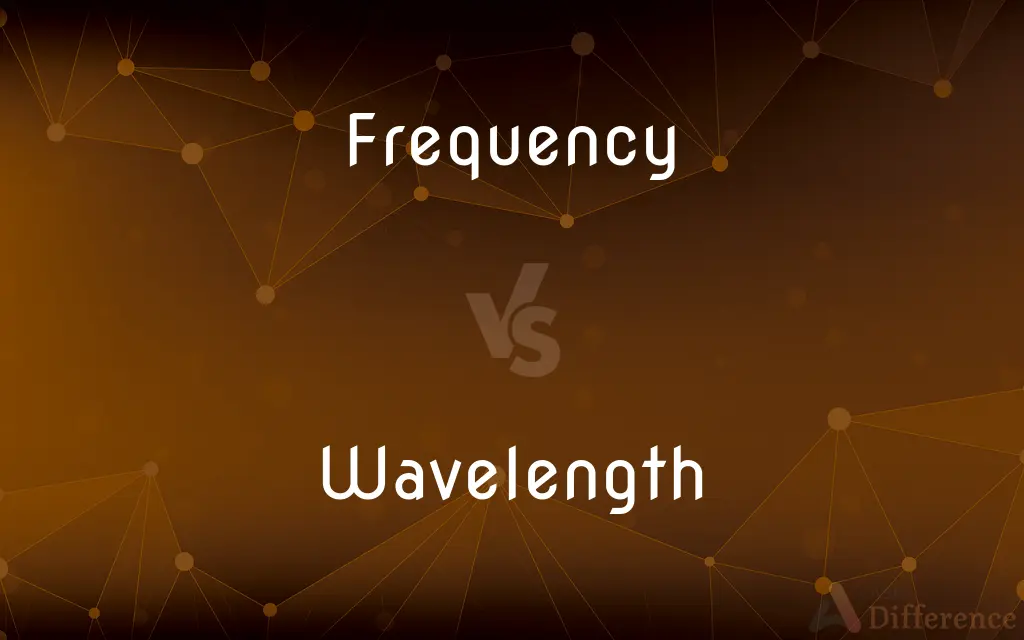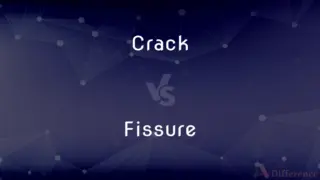Frequency vs. Wavelength — What's the Difference?
By Tayyaba Rehman — Published on September 6, 2023
Frequency denotes how often something occurs within a specific time frame, while wavelength refers to the distance between successive points of a wave.

Difference Between Frequency and Wavelength
Table of Contents
ADVERTISEMENT
Key Differences
Frequency characterizes the number of cycles of a wave that occur in one second. Wavelength, on the other hand, measures the spatial extent of these waves, denoting the distance between successive crests or troughs.
A higher frequency means that more cycles of a wave are passing a point per second. In contrast, a longer wavelength means that the distance between each cycle of a wave is greater.
In terms of light, frequency is directly related to its color; for instance, blue light has a higher frequency than red light. Wavelength, when discussing light, also relates to color, but inversely; blue light has a shorter wavelength than red light.
Sound waves provide another comparison: high-frequency sounds are perceived as high-pitched, while the wavelength of sound waves affects the directionality and propagation of the sound.
Radio and television broadcasts utilize specific frequency bands to transmit signals. The wavelength associated with these bands affects the signal's ability to travel distances and penetrate obstacles.
ADVERTISEMENT
Comparison Chart
Definition
Number of cycles per unit of time.
Distance between successive points of a wave.
Measurement Unit
Hertz (Hz) for wave occurrences per second.
Meters (m) or any distance unit for the length between wave points.
Perception in Sound
Relates to pitch.
Affects directionality and propagation.
Role in Light
Determines color (e.g., blue has higher frequency than red).
Also relates to color but inversely (e.g., blue has shorter wavelength than red).
Compare with Definitions
Frequency
The number of occurrences per unit time.
The frequency of the heartbeat was 80 beats per minute.
Wavelength
The distance between two successive points of a wave.
The wavelength of red light is longer than that of blue light.
Frequency
Regularity or repetitiveness of an event.
The frequency of her visits has decreased over time.
Wavelength
The distance between successive crests or troughs in a wave.
He studied the wavelength patterns of ocean waves.
Frequency
The statistical occurrence of a specific event.
The frequency of this genetic trait is low in the population.
Wavelength
A measure of the spatial extent of wave cycles.
Radio waves have longer wavelengths than microwaves.
Frequency
(uncountable) The property of occurring often rather than infrequently.
Wavelength
Characteristic of a wave determining its type and properties.
Different colors of light have different wavelengths.
Frequency
The rate at which something occurs over a particular period of time or in a given sample
An increase in the frequency of accidents due to increased overtime
Wavelength
In physics, the wavelength is the spatial period of a periodic wave—the distance over which the wave's shape repeats. It is the distance between consecutive corresponding points of the same phase on the wave, such as two adjacent crests, troughs, or zero crossings, and is a characteristic of both traveling waves and standing waves, as well as other spatial wave patterns.
Frequency
The number of measurements or observations having a certain value or characteristic.
Wavelength
Often used metaphorically to denote compatibility or shared understanding.
They were on the same wavelength during the meeting.
Frequency
A crowd; a throng.
Wavelength
The distance between one peak of a wave to the next corresponding peak, or between any two adjacent corresponding points, defined as the speed of a wave divided by its frequency.
Frequency
The ratio of the number of observations in a statistical category to the total number of observations
Wavelength
(physics) The length of a single cycle of a wave, as measured by the distance between one peak or trough of a wave and the next; it is often designated in physics as λ, and corresponds to the velocity of the wave divided by its frequency.
Frequency
Frequency is the number of occurrences of a repeating event per unit of time. It is also occasionally referred to as temporal frequency to emphasize the contrast to spatial frequency, and ordinary frequency to emphasize the contrast to angular frequency.
Wavelength
(figurative) A person's attitude and way of thinking as compared to another person's.
I think you and I are on a different wavelength.
Frequency
The number of repetitions per unit time of a complete waveform, as of an electric current.
Wavelength
The distance (measured in the direction of propagation) between two points in the same phase in consecutive cycles of a wave
Frequency
See relative frequency.
Wavelength
A shared orientation leading to mutual understanding;
They are on the same wavelength
Frequency
(countable) The quotient of the number of times a periodic phenomenon occurs over the time in which it occurs: .
Frequency
(statistics) number of times an event occurred in an experiment (absolute frequency)
Frequency
The condition of returning frequently; occurrence often repeated; common occurence; as, the frequency of crimes; the frequency of miracles.
The reasons that moved her to remove were, because Rome was a place of riot and luxury, her soul being almost stifled with, the frequencies of ladies' visits.
Frequency
The number of occurrences within a given time period (usually 1 second);
The frequency of modulation was 40 cycles per second
Frequency
The number of observations in a given statistical category
Frequency
The rate at which a wave oscillates in cycles.
Radio stations broadcast at different frequencies.
Frequency
Measurement of the number of waves that pass a point in one second.
Ultraviolet light has a higher frequency than visible light.
Frequency
The rate per second of a vibration constituting a wave, either in a material (as in sound waves), or in an electromagnetic field (as in radio waves and light)
Different thicknesses of glass will absorb different frequencies of sound
Frequency
The property or condition of occurring at frequent intervals.
Frequency
The number of repetitions of a complete sequence of values of a periodic function per unit variation of an independent variable.
Frequency
The number of complete cycles of a periodic process occurring per unit time.
Frequency
The rate of occurrence of anything; the relationship between incidence and time period.
With growing confidence, the Viking’s raids increased in frequency.
Common Curiosities
Is frequency always measured in Hertz?
Primarily yes, for waves, frequency is measured in Hertz, representing cycles per second.
How does frequency relate to energy?
In electromagnetic waves, higher frequency means higher energy.
Do longer wavelengths always mean lower frequencies?
Yes, for a given wave speed, longer wavelength corresponds to lower frequency.
How are frequency and wavelength used in communication?
Radios and TVs use specific frequencies to transmit, with associated wavelengths affecting signal quality.
Can we see different wavelengths of light?
Yes, different wavelengths correspond to different colors in the visible spectrum.
Can sound waves have varying frequencies and wavelengths?
Yes, varying frequencies give different pitches, and varying wavelengths affect sound propagation.
Do frequency and wavelength apply only to waves?
Primarily, but they can also be metaphorically used, like "being on the same wavelength" in communication.
How do blue and red lights differ in terms of frequency and wavelength?
Blue light has a higher frequency and shorter wavelength than red light.
Why is understanding frequency and wavelength important in science?
They help describe wave behaviors, impacting areas like communication, medicine, and energy.
Can frequency and wavelength change for a traveling wave?
While a wave's frequency remains constant, its wavelength can change if it enters a different medium.
Share Your Discovery

Previous Comparison
Skill vs. Talent
Next Comparison
Crack vs. FissureAuthor Spotlight
Written by
Tayyaba RehmanTayyaba Rehman is a distinguished writer, currently serving as a primary contributor to askdifference.com. As a researcher in semantics and etymology, Tayyaba's passion for the complexity of languages and their distinctions has found a perfect home on the platform. Tayyaba delves into the intricacies of language, distinguishing between commonly confused words and phrases, thereby providing clarity for readers worldwide.















































